BREAKING: Sandstone Solar Power Tower Project Application Withdrawn
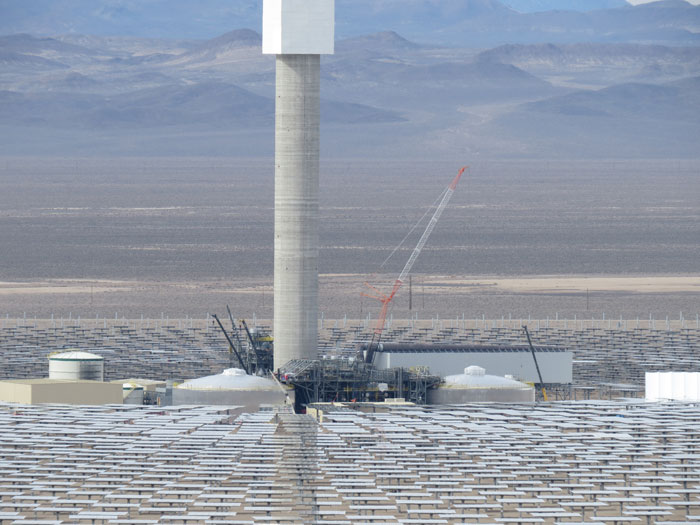
March 4, 2019 - Tonopah NV - We suspected something was up when Kevin Smith, CEO of SolarReserve resigned from the company he founded.
This, after years of cost overruns, bursting pipes and welding seams, and other porblems on the massive Crescent Dunes solar power tower that uses molten salt through its entire system: from tower reciver heated by solar energy, to the two molten salt tanks where this heat energy is transferred to conventional water-steam turbines to generate electricity for the gird.
SolarReserve had banked on infrastructure funding, or some other federal subsify, to build it's proposed super-massive ten additional solar power towers on public land adjacent to the Crescent Dunes Solar Project.
Smith was an original power tower engineer from the 1980s. He jumped ship to work with the fossil fuel company BP's solar arm, Lightsource BP. Which developes photovoltaic solar projects--not a good recommendation for Concentrated Solar Thermal technology.
We have been closely tracking this project, to the point of sending in numerous Freedom of Information Act requests, since the existing project has been controversial in the number of bird kills due to its intense solar flux.
Today, after an inquiry, the Bureau of Land Management confirmed to us in an email that the Sandstone Solar Project had withdrawn its application. No details were provided.
This will have major implications for any future renewable energy portfolio standard and New Green Deal, as hopes pinned on storing eneregy generated from solar power on expensive and problem-ridden molten salt tanks built to larger scale have suffered a setback.
We support renewable energy in the built environment, on rooftops, over parking lots, and using battery storage paired with photovoltaic panels.
Proposed Right-of-Way
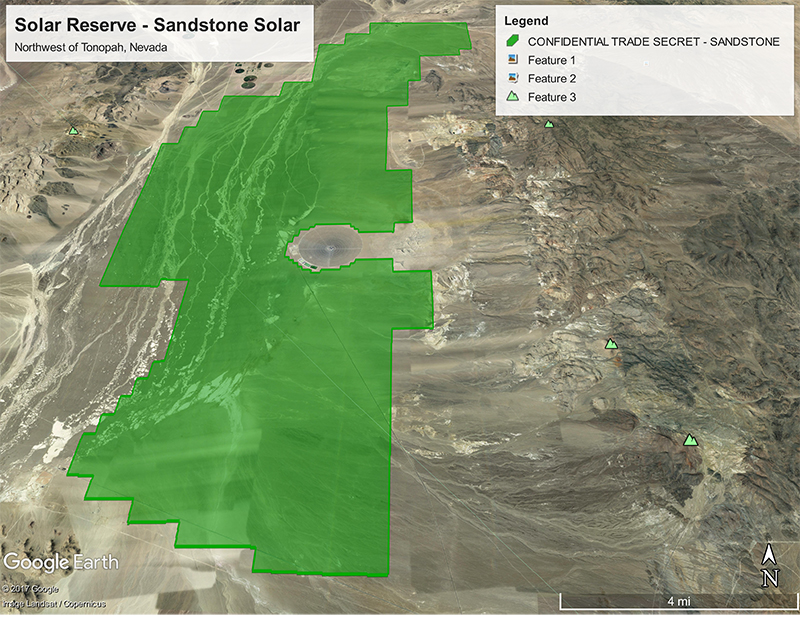
November 3, 2017 - This is the Google Earth KML File map of the proposed Sandstone Solar Project - the ten solar tower project proposed to be built by Solar Reserve in Big Smokey Valley, Nevada on 22,000 acres of BLM lands north of Tonopah. The small circle in the middle is the existing Crescent Dunes Solar Project. The project is so large it hugs the boundaries of the national forests! This project will most likely kill an unprecedented number of birds in the region through radiant solar flux. It will also most likely cause issues with military radar and visual resources.
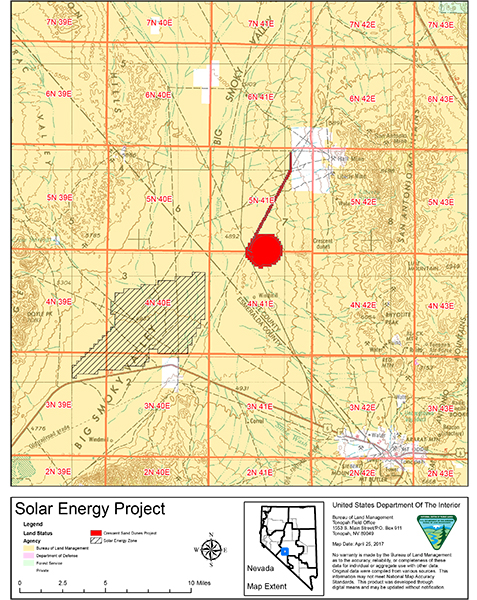
^This map shows the present Crescent Dunes Solar Energy Project in red, and the Miller's Solar Energy Zone in hatched lines to the southwest.
See The Las Vegas Review Journal article for more: https://www.reviewjournal.com/business/energy/developer-of-huge-solar-array-near-tonopah-wants-to-build-10-more/
Sandstone Solar Energy Project Proposed
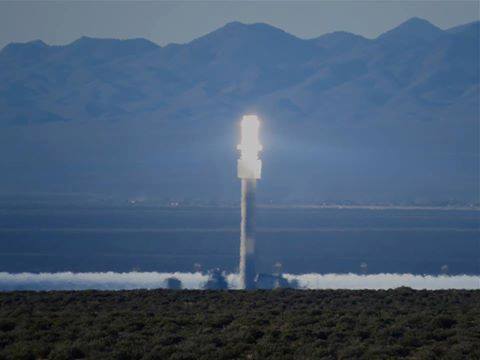
^The Crescent Dunes solar power tower in operation.
October 23, 2017 - Tonopah NV - On September 3 we attended a Nye County Commission meeting in Tonopah, where SolarReserve CEO Kevin Smith was in attendance to pitch his proposed Sandstone Solar Energy Project.
This is the preliminary map of the north section of the proposed 22,000 acre Sandstone North Solar Project, which would be up to a 10 tower concentrated solar thermal project located entirely on Bureau of Land Management lands (BLM), although documents obtained by Basin and Range Watch from BLM apparently indicate 8 solar power towers would be located on Variance lands designated under the Solar Programmatic Environmental Impact Statement Record of Decision; another two concentrated solar power plants/solar power towers might be in the Miller's Solar Energy Zone to the west of this, in Esmeralda County, Nevada. The map was obtained through a Freedom of Information Act Request (FOIA). See the Righ-of-Way Application for the Sandstone Solar Energy Project, Plants 1-8, submitted to the Tonopah BLM office >>here (PDF), obtained by FOIA.
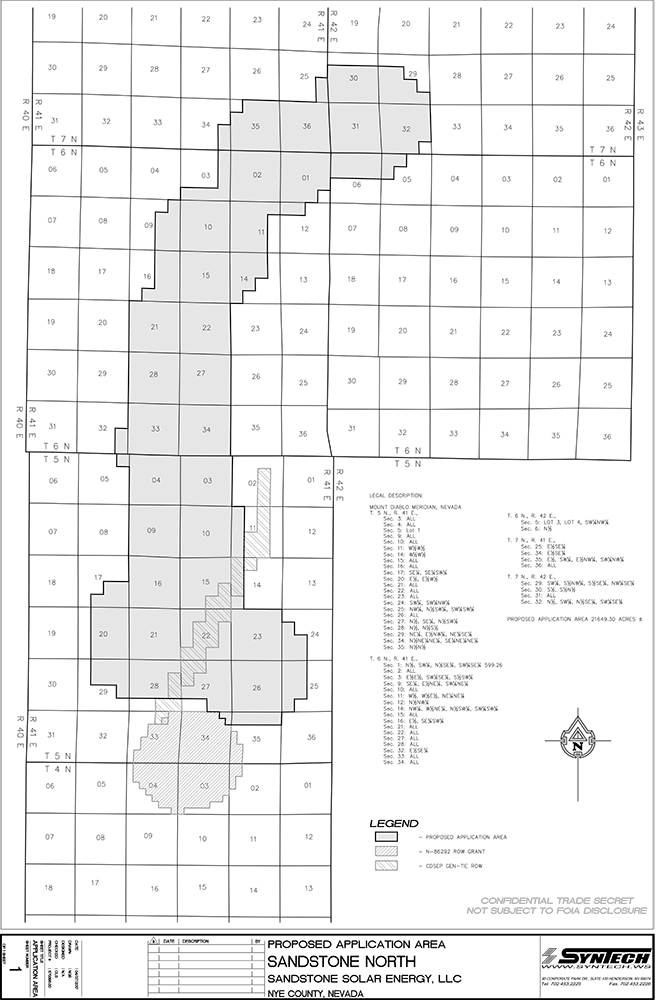
We will await the environmental review process to begin publicly to better understand the project and its impacts.
The project would use 2,000 acre feet of water per year, create 10 glowing visual impacts for Big Smokey Valley, and could kill birds from solar flux. SolarReserve is saying the project would cost $5 billion and would send the power to Nevada or California. Kevin Smith told the Nye County Commissioners that he believed the Sandstone Project would bring 3,000 jobs.
The Sandstone Solar Energy Project power towers would be taller than the current Crescent Dines solar power tower, with larger solar fields. The project could generate as much as 2,000 megawatts--as important as the Hoover Dam--SolarReserve told the Commissioners. The project still needs a Power Purchase Agreement with a utility, and would also need a large transmission upgrade. SolarReserve would like to start construction in 2020.
The northern project would be built just north of their existing Crescent Dunes Solar Project which was shut down for 8 months from technical difficulties. Kevin Smith claimed that Crescent Dunes Solar Energy Project generates 10 hours of storage. We would like to study the actual data. Smith said that battery storage has not achieved this scale, and we believe he is correct.
Crescent Dunes, Smith explained, can act like a fully-dispatchable power plant, that can be turned on and off. But we would like to understand the grid delay to load centers better--since Crescent Dunes is so remote, will this grid-balancing dispatchability take 10 minutes to reach Los Angeles on hundreds if miles of transmission lines, for example? More needs to be studied in this storage scenario in the real world.
Kevin Smith told the Commissioners, "Negative press is not so fun." We are partly to blame for the negative press, but we have yet to be convinced that the resource impacts are outweighed by the cost overruns, local job promises not kept, avian mortality, and long break-downs.
We are not alone.
Some Nye County Commissioners asked stinging questions about the project. Water came up as an issue: Commissioner John Koenig asked whether this would be a closed system? SolarReserve representatives revealed that Crescent Dunes solar power tower is actually a hybrid dry-wet cooling power plant (we has previously thought this was a dry-cooled only project). Wet-cooling towers require much more groundwater to evaporate and cool the system. SolarReserve said they were looking at obtaining 200 acre-feet per year for each solar power tower in the Sandstone project. They were looking at securing water rights from private sources.
Commissioner Butch Borasky stated that the jobs for Crescent Dunes solar project "was a joke." SolarReserve claimed a large tax revenue stream went to Nye County, But Commissioner Borasky said the state abated the county taxes.
Borasky stated that he thought most of the Nevada jobs came from Clark County--it helped the unions--but not labor sources in Nye County. A disagreement ensued. Kevin Smith said that if they did not meet a certain number of jobs, they paid a penalty to the County. He said they hired a ratio of 50:50 union and non-union jobs.
Borasky asked about the non-US citizen job numbers? Kevin Smith retorted that 90% of the work force was US, but some foreign specialty labor was brought in for the tall solar power tower construction (apparently from Spain). A discussion about hiring US labor by contractors followed. Commissioners told SolarReserve to make sure all contractors hire only e-verified workers.
Nye County Commissioner Donna Cox brought up her concerns about the project's impacts on birds being killed by the solar flux, removing the desert shrubs, and removing habitat for lizards and birds. She asked how SolarReserve would prevent bird mortality? Kevin Smith replied that in two years of biologists tracking avian mortality only 60-70 dead birds were found an an annual basis. SolarReserve assured the Commissioner that they work with BLM and US Fish and Wildlife Service to be in compliance. Mr. Smith said more bird deaths happen from collisions with cell towers and wind turbines, as well as buildings and feral cat predation.
The issue of the prairie falcon burned in the solar flux did not come up.
Commissioner Cox said if ten solar power towers were built, multiplying those annual avian mortality numbers could add up to a significant impact. "It becomes a big deal," she said. "I am concerned with the ecology." She mentioned concern over removing the desert shrubs in the large solar field, which impacts lizards and native mice.
Adam Green, Director of Development for SolarReserve, told the Commission, that sometimes if an area is not a vibrant area for predators to find prey, it will be less attractive.
Regardless of these well-founded concerns, on September 19, the Nye County Commission adopted a measure supporting SolarReserve. See the article in the Pahrump Valley Times by Daria Sokolova.
Crescent Dunes Solar Thermal Tower: Leaks and Safety Hazards, Yet SolarReserve Wants to Build Ten More
September 29, 2017 - Tonopah NV - On September 5, we attended a meeting of the Nye County Commissioners in Tonoaph, which was also videocast in Pahrump. The CEO of SolarReserve, Kevin Smith, gave a talk in person about his ideas to construct and operate a larger series of solar power towers near the original power plant at Crescent Dunes. The new project is just in the idea stages and does not have a Power Purchase Agreement, or financing, and no environmental review has publically begun.
The Sandstone Solar Energy Project would entail building up to 10 more solar power towers, each with molten salt storage, and up to 2,000 megawatts of energy generation.
Yet problems have plagued the Crescent Dunes solar power tower, with apparent weld problems in the pipes, and a leaking molten salt tanks that caused skin irritation and breathing issues with employees recently (see the article by Daria Sokolova in the Pahrump Valley Times). Nitrous oxide gas is a hazardous byproduct of molten salt, which is made of sodium nitrate and potassium nitrate, and releases need ventilation or hazards to workers may result.
SolarReserve Proposes Ten More Power Towers
October 25, 2016 - Tonopah NV - In a vague notice to select reporters, SolarReserve CEO Kevin Smith proclaimed he would build up to ten more solar power towers with molten salt storage, with 2 gigawatts of generation. The 16,000-acre project would be called "Sandstone." The location was not made clear except that it would be in Nye County, perhaps in southern Big Smoky Valley near Tonopah, on public land.
We have concerns about the transparency of the original Crescent Dunes Solar Energy Project that will be the model for new projects. For instance, the efficiency has been low, and we do not know exactly how much heat is stored after sunset to provide electricity. Does the molten salt storage work as advertised? Does efficiency drop in the cold winters around this southern Great Basin environment? How will bird mortality be avoided or mitigated? There are too many answers for us to support the huge land use cost of this proposal.
New transmission infrastructure will have to be built, and a new substation, causing more land impacts to desert ecosystems. Impacts to birds would be greater than urban starlings or house sparrows hitting an office building.
With California having problems now dealing with excess utility-scale solar energy at peak hours, storage is in demand. A much more efficient way to meet this demand would be Advanced Distributed Energy Resources: rooftop solar paired with local battery storage, energy efficiency, load-shifting technologies, and microgrids in urban centers. The impacts of more utility-scale solar projects to our public wild lands would be too great.
Diagrams shown at the press meeting gave the impression that the towers would be kept closer together to save on costs.
Except for a boom and bust of consyruction jobs in Tonopah itself, other Nye County residents see no economic benefit from this project in their county, especially as electricity will apparently be shipped to California.
More at the Las Vegas Review-Journal.
